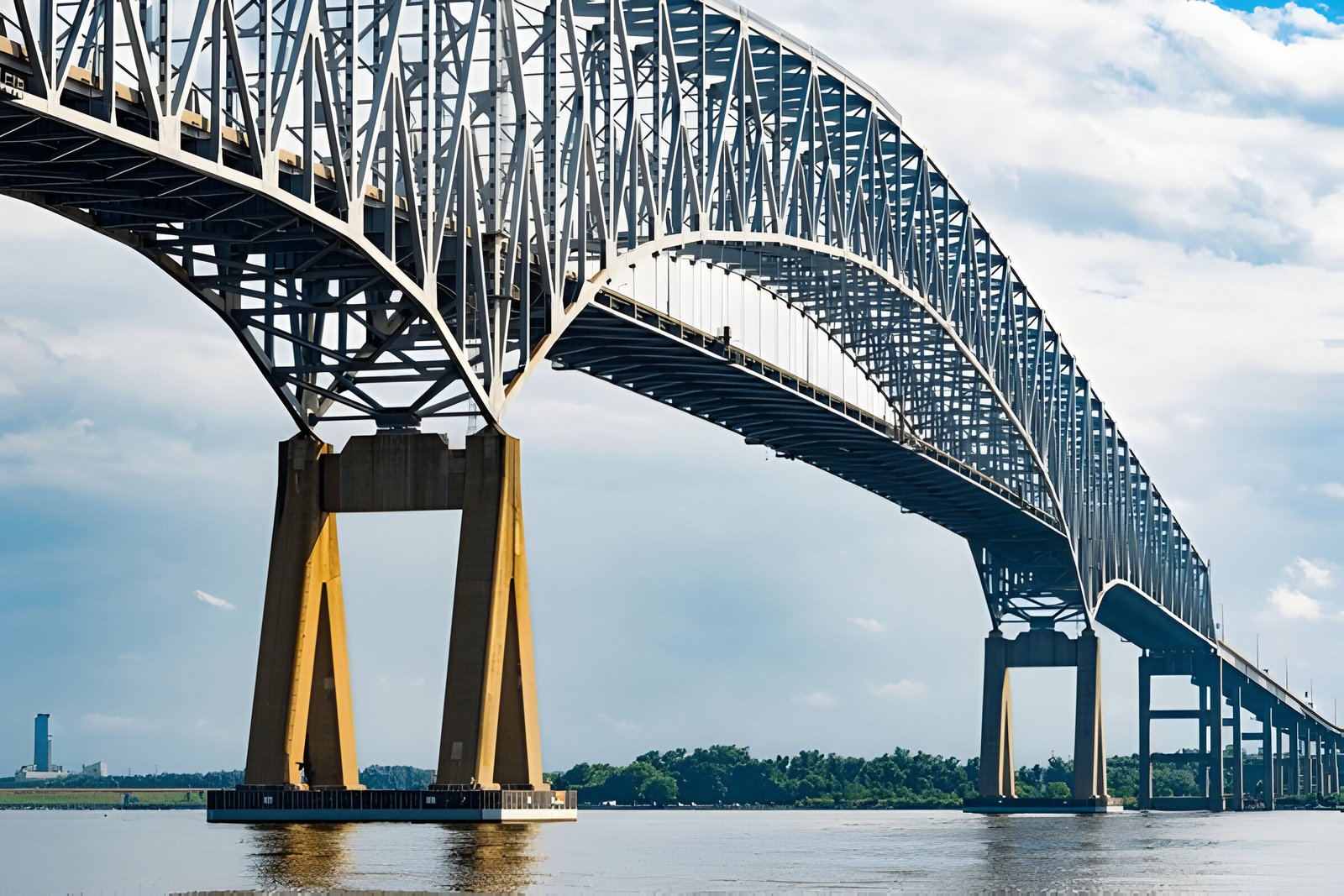Image Credit: ShutterStock
The Francis Scott Key Bridge in Baltimore stands as an iconic landmark, connecting the city’s diverse communities and serving as a vital artery for transportation. This impressive structure, spanning the Patapsco River, has played a crucial role in shaping Baltimore’s infrastructure and economy since its opening in 1977. The bridge’s distinctive design and strategic location have made it an essential part of the Baltimore skyline and a key component of the region’s transportation network.
As we delve into the history of the Francis Scott Key Bridge, we’ll explore its origins, engineering marvels, and lasting impact on Baltimore. This article will shed light on the bridge’s construction, its unique features, and how it has adapted to meet the changing needs of the city over the years. We’ll also examine the bridge’s significance in Baltimore’s transportation system and its influence on local commerce and community development. By understanding the story behind this remarkable structure, we can appreciate its enduring importance to Baltimore and the surrounding area.
The Birth of the Francis Scott Key Bridge
The Francis Scott Key Bridge, a vital artery in Baltimore’s transportation network, has a rich history dating back to the 1970s. This iconic structure, spanning 1.6 miles across the Patapsco River, has played a crucial role in connecting communities and facilitating commerce in the region.
Planning and Design
The planning for the Francis Scott Key Bridge began in the early 1970s, with construction commencing in 1972. The bridge was designed to span the lower Patapsco River area and the outer Baltimore Harbor Port, serving as a critical link in the city’s infrastructure. Engineers and planners aimed to create a structure that would not only meet the transportation needs of the growing metropolis but also stand as a testament to modern engineering capabilities.
Construction Challenges
Building the Francis Scott Key Bridge presented numerous challenges. The construction team had to work in the challenging environment of the Patapsco River, ensuring that the bridge could withstand the forces of nature and heavy traffic. The project required extensive coordination with various agencies, including the U.S. Coast Guard, as the bridge spanned navigable waters. This collaboration was essential to maintain maritime traffic during construction and ensure the safety of both workers and vessels.
Naming the Bridge
The naming of the bridge has an interesting backstory. Ben Womer, a local resident, lobbied hard to have the new bridge named after Francis Scott Key. His grandson, Marcus Womer, recalls his grandfather’s dedication to this cause, stating, “My grandfather fought really, really hard to get that name put on that bridge.” The choice of Francis Scott Key as the bridge’s namesake was rooted in the historical significance of Key to the Baltimore area.
Francis Scott Key, born into a wealthy plantation family, was a lawyer and amateur poet who famously wrote “The Defense of Fort M’Henry” after witnessing the bombardment of Fort McHenry during the War of 1812. This poem later became the lyrics to “The Star-Spangled Banner,” the national anthem of the United States. However, Key’s legacy is complex, as he also owned enslaved people and expressed views on race that are considered problematic by modern standards.
The Francis Scott Key Bridge opened to traffic in 1977, quickly becoming an integral part of Baltimore’s landscape and transportation system. Its completion marked a significant milestone in the city’s development, providing a crucial link for commuters and commerce alike.
Key Features and Engineering Marvels
The Francis Scott Key Bridge stands as a testament to innovative engineering and design, boasting several remarkable features that have made it a crucial part of Baltimore’s infrastructure.
francis scott key bridge baltimore
The bridge’s design is a marvel of engineering, utilizing a continuous through truss structure. This design allows the bridge to act as one long beam, distributing weight and stress more effectively across its entire length. The main span, measuring an impressive 1,200 feet (366 meters), was the third-longest span of any continuous truss in the world at the time of its construction. This structural approach not only enhanced the bridge’s stability but also contributed to its striking appearance on the Baltimore skyline.
Traffic Capacity
When it opened in 1977, the Francis Scott Key Bridge featured four lanes to accommodate traffic flow. However, to reduce initial costs, the approaches were constructed with only two lanes. As traffic demands increased, improvements were made to enhance capacity. In 1983, the south approach was widened, and after several years of delays, a project to expand the north approach was completed in 1999. These expansions allowed the bridge to handle an estimated 11.5 million vehicles annually, serving as a vital artery for commuters and commerce in the Baltimore metropolitan area.
Safety Measures
francis scott key bridge baltimore in the bridge’s design and subsequent improvements. Each of the bridge’s main piers was protected by dolphins, which are concrete structures designed to absorb impact and prevent ships from colliding directly with the piers. These dolphins featured a 25-foot-diameter sheet pile filled with tremie concrete and reinforced with a concrete cap. Additionally, a 17-foot fender system was installed, consisting of crushable thin-walled concrete boxes clad with timber members and steel plates at the base. These measures were implemented to enhance the bridge’s resilience against potential maritime accidents.
The Bridge’s Role in Baltimore’s Infrastructure
Impact on Local Transportation
francis scott key bridge baltimore has played a crucial role in Baltimore’s transportation network since its opening in 1977. Serving over 30,000 commuters daily, the bridge has been a vital artery for regional traffic flow. It carried an estimated 11.5 million vehicles annually, including many trucks transporting hazardous materials that are prohibited in the tunnels. The bridge’s importance became even more apparent following its recent collapse, which severed a critical transport corridor along the East Coast.
The collapse has led to significant traffic congestion in key areas. Analysis shows that freeway-to-freeway interchanges experienced the largest increase in travel times. Speed reductions were observed along I-95, I-895, and MD-295, with speeds dropping to as low as 10 mph on some road segments. The incident has compelled vehicles to reroute, disrupting the usual flow of goods and services.
Economic Significance
francis scott key bridge baltimore has been more than just a physical structure; it has been a cornerstone of Baltimore’s economic infrastructure. Its collapse has far-reaching economic implications, particularly for the state of Maryland. The potential impact is substantial, with estimates suggesting that even a 30-day closure of the port could result in a USD 550 million loss to Maryland’s GDP and a USD 1 billion loss in total value of goods and services.
Connection to the Port of Baltimore
The bridge’s connection to the Port of Baltimore has been integral to the region’s economy. The port is a vital economic hub, supporting thousands of jobs and businesses. It serves as a crucial gateway for specialized cargo and bulk handling, ranking at or near the top of all U.S. ports in handling various goods, including farm and construction machinery, automobiles, and imported forest products.
The port generates nearly USD 3.30 billion in total personal income and supports over 15,000 direct jobs, with an additional 139,000 jobs connected to port work. The bridge’s collapse has temporarily closed the port, potentially leading to significant disruptions in the flow of goods, affecting businesses that rely on timely deliveries, and causing ripple effects throughout the local and regional economy.
Conclusion
The Francis Scott Key Bridge has left an indelible mark on Baltimore’s landscape and infrastructure. Its construction and ongoing improvements have had a significant impact on the city’s transportation network, easing traffic flow and connecting communities. The bridge’s role in supporting the Port of Baltimore has been crucial, contributing to the region’s economic vitality and job creation. This iconic structure stands as a testament to engineering prowess and adaptability in the face of growing urban needs.
Recent events have underscored the bridge’s importance to Baltimore and the wider region. Its sudden absence has led to major disruptions in traffic patterns and economic activities, highlighting the interdependence of infrastructure and commerce. As the city looks to the future, the legacy of the Francis Scott Key Bridge serves as a reminder of the need for robust, forward-thinking infrastructure planning to support urban growth and economic development.
Also Read: fort lauderdale-hollywood international airport news
FAQs
- What is the historical significance of the Francis Scott Key Bridge in Baltimore?
The Francis Scott Key Bridge holds historical importance as it is located near the site where Francis Scott Key witnessed the British bombardment of Fort McHenry in 1814. This event inspired him to write “The Defense of Fort M’Henry,” a poem that later became the lyrics for the U.S. national anthem, “The Star-Spangled Banner.” - Why did Francis Scott Key visit Baltimore in 1814?
Francis Scott Key traveled to Baltimore in early September 1814 on a mission to negotiate with the British fleet for the release of his friend, Dr. William Beanes. This occurred shortly after the British had attacked Washington, D.C.
























[…] […]
[…] […]